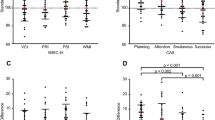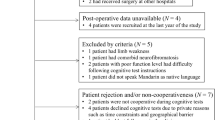Abstract
We wanted to determine the neurocognitive profile of adult patients with moyamoya disease prior to neurosurgical intervention. The experience of three United States medical centers, Columbia University, University of Illinois at Chicago, and the University of Texas Southwestern Medical Center at Dallas, were combined. Clinical data from adult patients (N = 29) referred for neuropsychological evaluation from 1996 to 2008 were reviewed. Neurocognitive functioning was assessed using standardized neuropsychological tests and all data were converted to z-scores. Memory, attention, processing speed, verbal memory, visuo-spatial, language, and executive functions were examined. Cognitive dysfunction was defined as performance in two or more cognitive domains 1.5 standard deviations below age-corrected normative means OR one or more cognitive domains two standard deviations below age-corrected normative means. Manual strength and dexterity, as well as depressive symptoms, were also assessed. Two-thirds of patients demonstrated neurocognitive dysfunction. A large proportion of patients were found to have pronounced cognitive dysfunction (>2 SD below the mean) on tests of processing speed (29%), verbal memory (31%), verbal fluency (26%) and executive function (25%). Manual strength and dexterity were also affected in many patients, with impairment found in 36–58% of patients. Twenty-eight percent of patients reported moderate to severe depression, but depressive symptoms did not correlate with neurocognitive findings. A large proportion of adults with moyamoya disease demonstrate disruption of neurocognition in a broad range of functions, particularly those mediated by subcortical and frontal regions. The pattern of deficits suggests a mechanism of diffuse small vessel disease possibly caused by chronic hypoperfusion.
Similar content being viewed by others
References
Beck A, Steer R, Brown G (1996) Beck depression inventory, 2nd edn. The Psychological Corporation, San Antonio
Benton A, Hamsher K (1989) Multilingual aphasia examination. AJA Associates, Iowa City
Bornstein RA (1985) Neuropsychological performance in Moya Moya disease: a case study. Int J Neurosci 26:39–46
Brandt J, Benedict R (2001) Hopkins verbal learning test-revised. Psychological Assessment Resources, Odessa
Chiu D, Shedden P, Bratina P, Grotta JC (1998) Clinical features of moyamoya disease in the United States. Stroke 29:1347–1351
Chmayssani M, Festa JR, Marshall RS (2007) Chronic ischemia and neurocognition. Neuroimaging Clin N Am 17:313–324
Choi JU, Kim DS, Kim EY, Lee KC (1997) Natural history of moyamoya disease: comparison of activity of daily living in surgery and non surgery groups. Clin Neurol Neurosurg 99(suppl 2):S11–S18
Delis D, Kramer J, Kaplan E, Ober B (1994) California verbal learning test, 2nd edn. Adult Version. The Pyschological Corporation, San Antonio
Hachinski V, Iadecola C, Petersen RC, Breteler MM, Nyenhuis DL, Black SE, Powers WJ, DeCarli C, Merino JG, Kalaria RN, Vinters HV, Holtzman DM, Rosenberg GA, Wallin A, Dichgans M, Marler JR, Leblanc GG (2006) National Institute of Neurological Disorders and Stroke-Canadian Stroke Network vascular cognitive impairment harmonization standards. Stroke 37:2220–2241 (see comment) [erratum appears in Stroke. 2007 Mar;38(3):1118 Note: Wallin, Anders (added)]
Hallemeier CL, Rich KM, Grubb RL Jr, Chicoine MR, Moran CJ, Cross DT III, Zipfel GJ, Dacey RG Jr, Derdeyn CP (2006) Clinical features and outcome in North American adults with moyamoya phenomenon. Stroke 37:1490–1496
Heaton R, Chelune G, Talley J, Kay G, Curtiss G (1993) Wisconsin card sorting test manual revised and expanded. Psychological Assessment Resources, Odessa
Ikezaki K, Han DH, Kawano T, Kinukawa N, Fukui M (1997) A clinical comparison of definite moyamoya disease between South Korea and Japan. Stroke 28:2513–2517
Jefferson AL, Glosser G, Detre JA, Sinson G, Liebeskind DS (2006) Neuropsychological and perfusion MR imaging correlates of revascularization in a case of moyamoya syndrome. AJNR Am J Neuroradiol 27:98–100
Kaplan E, Goodglass H, Weintraub S (1983) The Boston naming test, 2nd edn. Lea and Feinberg, Philadelphia
Karzmark P, Zeifert PD, Tan S, Dorfman LJ, Bell-Stephens TE, Steinberg GK (2008) Effect of moyamoya disease on neuropsychological functioning in adults. Neurosurgery 62:1048–1051 (discussion 1051–1042)
Kim JM, Lee SH, Roh JK (2009) Changing ischaemic lesion patterns in adult moyamoya disease. J Neurol Neurosurg Psychiatry 80:36–40
Kraemer M, Heienbrok W, Berlit P (2008) Moyamoya disease in Europeans. Stroke 39:3193–3200
Lezak M, Howieson D, Loring D, Hannay H, Fischer J (2004) Neuropsychological assessment, 4th edn. Oxford University Press, New York
Matthews C, Klove K (1964) Instruction manual for the adult neuropsychological test battery. University of Wisconsin Medical School, Madison
Mula M, Trimble MR, Mula M, Trimble MR (2009) Antiepileptic drug-induced cognitive adverse effects: potential mechanisms and contributing factors. CNS Drugs 23:121–137
Nakashima H, Meguro T, Kawada S, Hirotsune N, Ohmoto T (1997) Long-term results of surgically treated moyamoya disease. Clin Neurol Neurosurg 99(suppl 2):S156–S161
Nelson H, Willison J (1991) National adult reading test (NART): test manual, 2nd edn. NFER Nelson Windsor, UK
Numaguchi Y, Gonzalez CF, Davis PC, Monajati A, Afshani E, Chang J, Sutton CL, Lee RR, Shibata DK (1997) Moyamoya disease in the United States. Clin Neurol Neurosurg 99(suppl 2):S26–S30
Ogasawara K, Komoribayashi N, Kobayashi M, Fukuda T, Inoue T, Yamadate K, Ogawa A (2005) Neural damage caused by cerebral hyperperfusion after arterial bypass surgery in a patient with moyamoya disease: case report. Neurosurgery 56:E1380 (discussion E1380)
Radloff L (1977) The CES-D scale: a self-report depression scale for research in the general population. Appl Psychol Meas 1:385–401
Reitan R, Wolfson D (1985) The Halstead Reitan neuropsychological test battery. Neuropsychological Press, Tucson
Reitan R, Wolfson D (1993) The Halstead Reitan neuropsychological test battery: theory and clinical applications, 2nd edn. Neuropsychological Press, Tucson
Starke RM, Komotar RJ, Hickman SL, Paz YE, Pugliese AG, Otten ML, Garrett MC, Elkind MSV, Marshall RS, Festa JR, Meyers PM, Connolly ES (2009) Clinical features, surgical treatment, and long-term outcome of adult moyamoya patients. J Neurosurg 111:936–942
Takeuchi K, Shimizu K (1957) Hypogenesis of bilateral internal carotid arteries. No To Shinkei 9:37–43
Wechsler D (1990) Wechsler abbreviated intelligence scale. The Psychological Corporation, San Antonio
Wechsler D (1991) Wechsler test of adult reading. The Psychological Corporation, San Antonio
Wechsler D (1997) Wechsler adult intelligence scale, 3rd edn. The Psychological Corporation, San Antonio
White J, Hopkins RO, Glissmeyer EW, Kitterman N, Elliott CG (2006) Cognitive, emotional, and quality of life outcomes in patients with pulmonary arterial hypertension. Resp Res 7:55
Wityk RJ, Hillis A, Beauchamp N, Barker PB, Rigamonti D (2002) Perfusion-weighted magnetic resonance imaging in adult moyamoya syndrome: characteristic patterns and change after surgical intervention: case report. Neurosurgery 51:1499–1505 (discussion 1506)
Wright CB, Festa JR, Paik MC, Schmiedigen A, Brown TR, Yoshita M, DeCarli C, Sacco R, Stern Y (2008) White matter hyperintensities and subclinical infarction: associations with psychomotor speed and cognitive flexibility. Stroke 39:800–805
Yilmaz EY, Pritz MB, Bruno A, Lopez-Yunez A, Biller J (2001) Moyamoya: Indiana University Medical Center experience. Arch Neurol 58:1274–1278
Yonekawa Y, Ogata N, Kaku Y, Taub E, Imhof HG (1997) Moyamoya disease in Europe, past and present status. Clin Neurol Neurosurg 99(suppl 2):S58–S60
Acknowledgment
This work was supported in part by NIH:NCRR M01 RR 00645-27 Pilot Award, 2004.
Conflicts of interest statement
There are no conflicts of interests to report.
Author information
Authors and Affiliations
Corresponding author
Rights and permissions
About this article
Cite this article
Festa, J.R., Schwarz, L.R., Pliskin, N. et al. Neurocognitive dysfunction in adult moyamoya disease. J Neurol 257, 806–815 (2010). https://doi.org/10.1007/s00415-009-5424-8
Received:
Revised:
Accepted:
Published:
Issue Date:
DOI: https://doi.org/10.1007/s00415-009-5424-8




